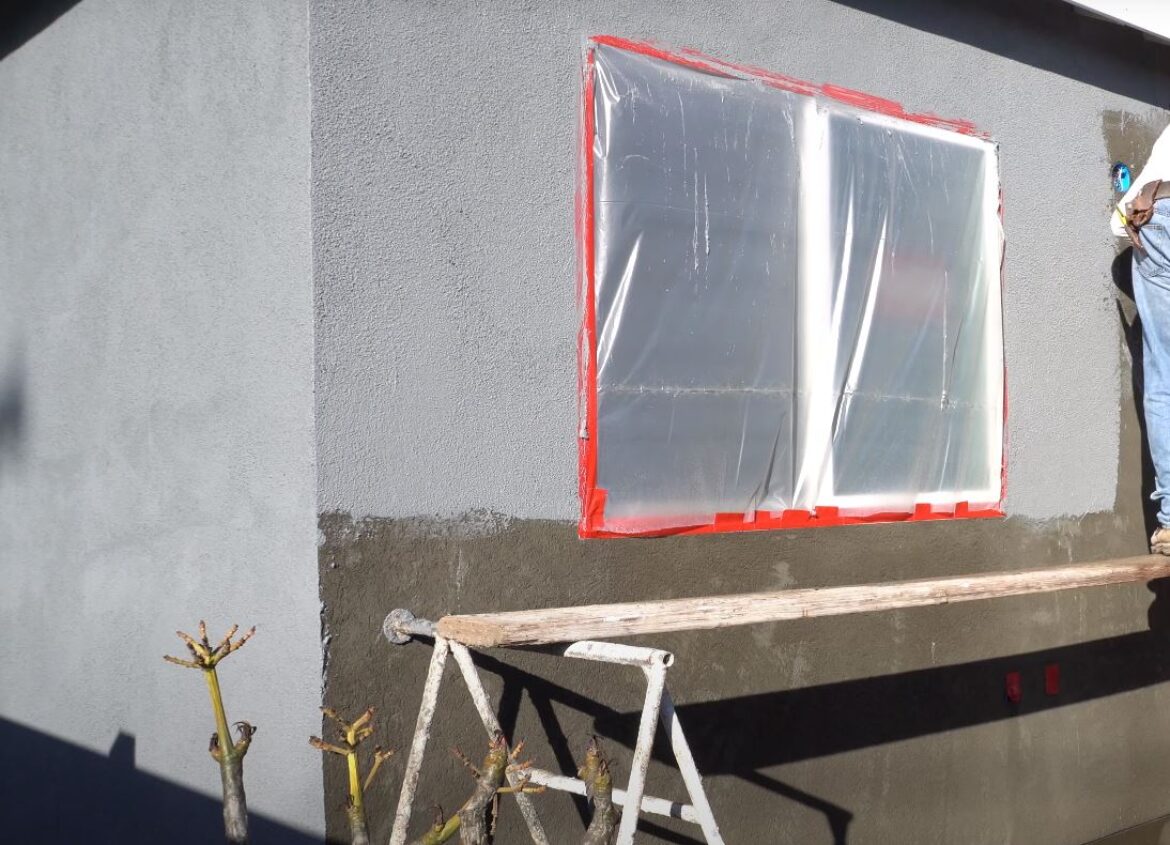Can Stucco Be Painted or Tinted?
The Basics of Stucco
Stucco, often used as an exterior finish, is a blend of cement, sand, lime, and water. It provides a robust and textured finish, making it a favourite in many Auckland suburbs, including Ponsonby and Mt. Eden. With its distinct appeal, homeowners often ponder, “Can stucco be painted or tinted?” To answer this question, let’s delve deeper into the properties of stucco and its interaction with paints and tints.
Painting Stucco: Benefits and Process
While the rugged texture and earthy appeal of stucco are undeniably charming, the prospect of painting stucco opens up a new dimension of aesthetic possibilities. Painting not only offers a makeover for the walls but also introduces a range of practical benefits. Let’s explore these facets in depth:
Benefits of Painting Stucco:
-
- Revitalisation: A fresh coat of paint breathes new life into aging or discoloured stucco surfaces.
- Protection: Paint acts as a sealant against the unpredictable Auckland weather, safeguarding stucco from moisture, UV rays, and contaminants.
- Energy Efficiency: Certain paints have reflective properties, reducing the absorption of heat and potentially lowering cooling costs in warmer months.
- Flexibility: Painting offers the freedom to switch colours, accommodating changing tastes or design trends over time.
Detailed Painting Process:
- Surface Assessment: Before diving into the painting process, inspect the stucco for cracks, mould, or any signs of deterioration. Addressing these issues beforehand ensures a smoother paint application.
- Surface Preparation: Beyond cleaning, this step might require repairing any damages. Use a power washer to remove dirt, followed by patching up cracks or holes with a stucco repair compound.
- Choosing the Right Paint: Not every paint is suited for stucco. Acrylic paints, known for their breathability and flexibility, are recommended. These paints allow any trapped moisture to escape, minimising potential damage.
- Priming: This step is pivotal. A good quality masonry primer ensures not only better adhesion of the paint but also enhances its vibrancy and sheen.
- Paint Application: Use a roller for larger surfaces and brushes for detailed work around windows and edges. It’s often advisable to apply two coats, ensuring an even and lasting finish.
- Drying and Curing: While the paint might feel dry to touch within hours, it’s essential to let it cure for a few days for optimal durability.
Considerations for Longevity:
-
- Maintenance: Regularly inspect the painted surface for any signs of wear or damage. Addressing small issues proactively can prevent larger complications down the track.
- UV Protection: To maximise the paint’s lifespan, considering UV-resistant paints can be beneficial. They prevent premature fading, especially under the intense Auckland sun.
To wrap up, painting stucco isn’t just an aesthetic decision but a strategic one. If done correctly, with attention to detail and quality materials, it enhances the lifespan of the stucco while providing homeowners with a refreshed look for their abode.
Tinting Stucco: Dive into the Colour
Stucco tinting is an art form that combines the beauty of colour with the robustness of stucco. It offers homeowners a distinct look, giving them the chance to truly make their homes a reflection of their personal style. Here’s a comprehensive dive into the world of stucco tinting:
- Understanding the Science: Unlike painting, which sits on the surface, tinting incorporates colour pigments directly into the stucco mixture. These pigments react chemically with the cement content in stucco, ensuring the colour remains vibrant and consistent throughout the material’s depth.
- Advantages of Tinting Over Painting:
-
- Durability: Tinted stucco does not face issues like peeling, flaking or fading as readily as painted stucco because the colour is integrated into the material itself.
- Maintenance: Tinted stucco requires less frequent touch-ups, making it a long-term economical choice.
- Texture Preservation: Tinting doesn’t add an extra layer to the stucco, ensuring the natural texture and feel of stucco is preserved.
Process of Tinting:
- Selection of Pigment: Choose quality pigments that are UV-resistant and compatible with stucco mixes.
- Mixing: Pigments are blended into the stucco mixture in precise proportions. Proper mixing ensures even colour distribution.
- Application: Once mixed, the tinted stucco is applied in the same manner as regular stucco. As it dries, the colour emerges more vividly.
- Curing: Allow the stucco to cure. This is a crucial phase as the stucco solidifies and the full depth of the colour becomes apparent.
- Customisation Opportunities: One of the biggest attractions of tinting is the vast colour palette available. From earthy tones reminiscent of Ponsonby’s historic buildings to the vibrant hues that mirror Mt. Eden’s lively streets, there’s a shade for every preference.
- Environmental Impact: It’s worth noting that tinting stucco has a lesser environmental footprint than painting. There are no VOC emissions, and without the need for periodic repainting, the environmental strain from paint production and disposal is reduced.
Health and Safety Considerations
- Use of Chemicals: Both the painting and tinting processes involve chemicals. Ensure adequate ventilation and wear safety equipment, like masks and gloves.
- Risk of Asbestos: Older homes (pre-1980s) in Auckland might have stucco containing asbestos. If there’s any suspicion, it’s crucial to get a professional assessment before any painting or tinting.
- Working at Heights: Painting exterior walls often requires ladders or scaffolding. Proper training and safety measures are essential to avoid falls.
Different Types of Plastering: Risks and Precautions
- Solid Plastering: This technique applies plaster products on surfaces. Risks include potential chemical burns from wet plaster and the inhalation of dust. It’s crucial to wear gloves and dust masks.
- Fibrous Plastering: This uses ornamental plasterwork. Sharp tools can lead to cuts, so proper handling and protective gloves are essential.
- Fireproof Plastering: Involves plastering materials that can withstand high temperatures. The main risk is the potential for burns, making fire-resistant gloves a must.
Exceptions to Consider
- Moisture Content: Painting stucco with high moisture content can lead to peeling or blistering. Always ensure the stucco is thoroughly dry.
- New Stucco: Fresh stucco needs to cure for at least six weeks before painting to ensure optimal results.
- Existing Paint Type: Latex paint over oil-based paint can lead to compatibility issues. It’s always advisable to seek expert guidance.
Engage the Experts
Stucco’s versatility is undeniable, offering both aesthetic and protective benefits. If you’re contemplating whether to paint or tint your stucco, seeking expert advice ensures a seamless and enduring finish. Your Plasterers Auckland brings expertise, ensuring your plastering project not only meets but exceeds expectations.
Frequently Asked Questions on “Can Stucco Be Painted or Tinted?”
Is it better to paint or tint stucco?
Both options have their merits. Painting offers flexibility in changing colours over time and can act as a protective sealant against environmental elements. Tinting integrates the colour directly into the stucco mixture, ensuring the shade remains consistent even if the surface is damaged. Your choice depends on your aesthetic preferences and long-term plans for the property.
How long should I wait to paint new stucco?
It’s recommended to wait at least six weeks before painting new stucco. This allows it to fully cure and ensures optimal paint adhesion.
Do I need to prime stucco before painting?
Yes, priming is a crucial step. A quality masonry primer ensures better adhesion, enriches colour vibrancy, and provides an additional protective layer.
Can I change the colour of my stucco if I don’t like the tint?
Absolutely. If you’re not satisfied with a stucco tint, you can paint over it. However, remember to follow the proper painting process for the best results.
Does painting stucco affect its breathability?
It depends on the type of paint. Acrylic paints are recommended for stucco because they’re breathable, allowing trapped moisture to evaporate, thus reducing potential damage.
How often will I need to repaint stucco?
Typically, painted stucco can last between 5 to 10 years before requiring a new coat, depending on the paint quality, exposure to elements, and maintenance.
Is tinting stucco more expensive than painting?
Cost can vary based on location, labour rates, and material quality. Generally, tinting might have a higher upfront cost due to the pigments used, but it might be more economical in the long run given its durability and less frequent need for touch-ups.
Can I DIY paint or tint my stucco?
While DIY is possible, stucco painting and tinting require specific techniques and knowledge for the best results. Mistakes can be costly to rectify. Engaging professionals, like Your Plasterers Auckland, can ensure a seamless and high-quality finish.
Are there any environmental benefits to tinting over painting?
Yes, tinted stucco generally has a lower environmental footprint. There are no VOC emissions typical of some paints, and without the need for periodic repainting, there’s less environmental strain from paint production and disposal.
Can I fix cracks in my stucco before painting or tinting?
Certainly. In fact, it’s recommended to repair any cracks or damages in the stucco before painting or tinting to ensure a smooth and even finish. Make sure to use a stucco repair compound compatible with your stucco type.
Key Takeaways
- Versatility: Both painting and tinting stucco offer aesthetic versatility. Your choice depends on personal preference and long-term property plans.
- Curing Time: New stucco requires at least six weeks of curing before it’s ready for paint, ensuring proper adhesion.
- Primed for Success: Priming stucco before painting enhances paint adhesion, colour vibrancy, and offers added protection.
- Paint Breathability: Acrylic paints are ideal for stucco due to their breathable nature, preventing trapped moisture and potential damage.
- Durability: Painted stucco generally lasts 5 to 10 years, while tinted stucco’s colour is more integrated, offering potentially longer-lasting results.
- Cost Considerations: Tinting might have a higher initial cost compared to painting, but it can be economical long-term due to its durability.
- DIY Challenges: While painting or tinting stucco can be a DIY project, achieving professional-quality results requires specific techniques and knowledge.
- Eco-friendly Tinting: Tinted stucco often has a lower environmental footprint compared to painted stucco, reducing VOC emissions and paint production strain.
- Repairs First: Always address cracks or damages in stucco before painting or tinting to ensure a uniform finish.
- Professional Expertise: Engaging with professionals, like Your Plasterers Auckland, guarantees top-quality finishes and avoids potential DIY mishaps.

